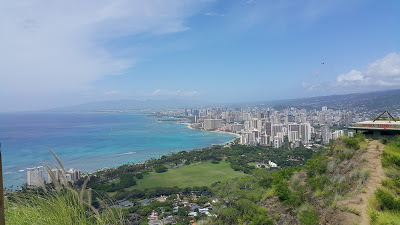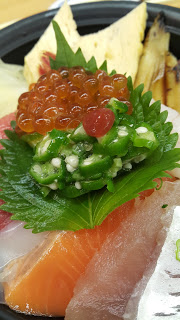 or – Why Are We Awake So Early Just to Watch Fish Being Sold at Tsukiji Fish Markets?
or – Why Are We Awake So Early Just to Watch Fish Being Sold at Tsukiji Fish Markets?
I’ve just survived an incredibly long evening with some of my really good friends who were here for a friend’s birthday. We decided to do a once in a lifetime experience. It really is something I’ll only be doing once.
An after dinner nap and we were out of my place at 12.30am Saturday to see the Fish Auction at Tsukiji Markets. The Market itself has been there for the past 81 years and it may be relocating in the not too distant future though there is some uncertainty around this at the moment.
The first auction visitors can see is at 5.25am and lasts for about 20 minutes. The early start we had was to meet our guide at 1am so we could join the queue to register at 2am. We didn’t want to miss out as only 120 people per day are allowed into the auction. Even then, this is split into two groups of 60. As a result, queuing starts early. Entry is free. No alcohol allowed.
Registration involves going through the Information Centre, collecting a high visibility vest (yellow if you’re in the first group and green if you’re in the second) while being ushered into the waiting room that’s roughly the size of a small shipping container. Once the vests run out, the registration process is complete and no more people can enter.
The room is split in two, everyone in yellow stands on one side and once 60 people had entered, we were allowed to sit down. At that stage, we were squashed quite far forward so it made it difficult to stretch our legs out or lie down for the next few hours of waiting. The better prepared groups brought playing cards and / or pillows. In the meantime, the green side were much more spread out as it hadn’t filled yet and people slept in all sorts of positions.
At 4am, we were joined by Kosiei, a 19 year tuna auction veteran (and seemingly a part-time comedian) who told us what we were about to see. If you think 19 years is quite a lot of experience, his boss has 57!
The market is huge and trades about JPY2bn per day, 85% being fish products and 15% being fruit and vegetables, employing about 14,000 people. We were there to see the tuna auction.
 Kosiei told us what he looks for in the perfect tuna – the shape (not too thin or too thick), he then digs some of the flesh from where the tail was with his hook (the tail having been discarded and a thin chunk of tail meat is placed on the fish), rolls it in his fingers to assess the fat content (moderately fatty) before using his flashlight to see if the flesh color is bright red. Once he’s done all of this, he decides what price he is prepared to pay or if he’ll bother bidding at all.
Kosiei told us what he looks for in the perfect tuna – the shape (not too thin or too thick), he then digs some of the flesh from where the tail was with his hook (the tail having been discarded and a thin chunk of tail meat is placed on the fish), rolls it in his fingers to assess the fat content (moderately fatty) before using his flashlight to see if the flesh color is bright red. Once he’s done all of this, he decides what price he is prepared to pay or if he’ll bother bidding at all.
Bidding begins with the aucitoneer ringing a bell which then sets off a flurry of hand gestures. Each bidder uses the same gestures which indicate a certain value depending on how they hold their fingers and move their hands. It’s price per kilo and watching the process is like watching jazz hands. The whole process averages six seconds per fish.
The wholesalers then move the fish to the intermediate wholesale area where the fish are cut and sold to restuarants, supermarkets and elsewhere. These prices are based both on what was spent at the auction as well as a mark up depending on the part of the fish and the fat content.
 The tuna itself has potentially come from quite a distance – Atlantic, Pacific, Mediterranean, as well as the coast of Japan. The colder the water, the more fatty the tuna and the better that is. For the more well-travelled tuna, it was caught, gutted, stored in the ship’s freezer at -60C and brought to auction up to a year later as the fishermen wait until their freezers are full before returning.
The tuna itself has potentially come from quite a distance – Atlantic, Pacific, Mediterranean, as well as the coast of Japan. The colder the water, the more fatty the tuna and the better that is. For the more well-travelled tuna, it was caught, gutted, stored in the ship’s freezer at -60C and brought to auction up to a year later as the fishermen wait until their freezers are full before returning.
Kosiei noted that the tuna levels are falling which is why there are lower quotas now and also why the Japanese have started experimenting with tuna farming. As the country that consumes about a quarter of the tuna caught globally, this seems to be a good idea.
He was a very passionate man and clearly enjoyed his role as well as educating the public about it and tuna in general.
Once we heard his talk, we continued waiting before the police came to collect us at 5.20am. They escorted the yellow group to the auction area which was more like a warehouse filled with frozen fish on raised pallets, in sectioned off areas for each wholesaler, while the bidders poked and prodded the various fish on display with their hooks and torches.
We were in another roped off area to take photos and watch how it all unfolded. Interesting, fast and only needs to be done once in my life.
 The biggest tuna ever sold at auction was about 400kgs with the average closer to 100kgs. The most paid was at the first auction of the year in 2013 (the first auction of the year always has the highest price) for JPY155 million by Kiyoshi Kimura. He’s the president of a sushi chain and the resulting publicity makes it worth his while to spend this kind of money. This year was the fifth time in a row he has been the highest bidder.
The biggest tuna ever sold at auction was about 400kgs with the average closer to 100kgs. The most paid was at the first auction of the year in 2013 (the first auction of the year always has the highest price) for JPY155 million by Kiyoshi Kimura. He’s the president of a sushi chain and the resulting publicity makes it worth his while to spend this kind of money. This year was the fifth time in a row he has been the highest bidder.
Leaving here, we were again escorted to back to the starting point to take off our yellow vests. The escort is to make sure we get to the right spot and also so we don’t interfere with the auction and the operation of the market, as well as for our own safety since there are little turrets hooning around very quickly, no indicators and we are just in the way.
It was then time for breakfast – fish.
* Thanks to Mr Scruff for the title to this post. Interesting tune…

